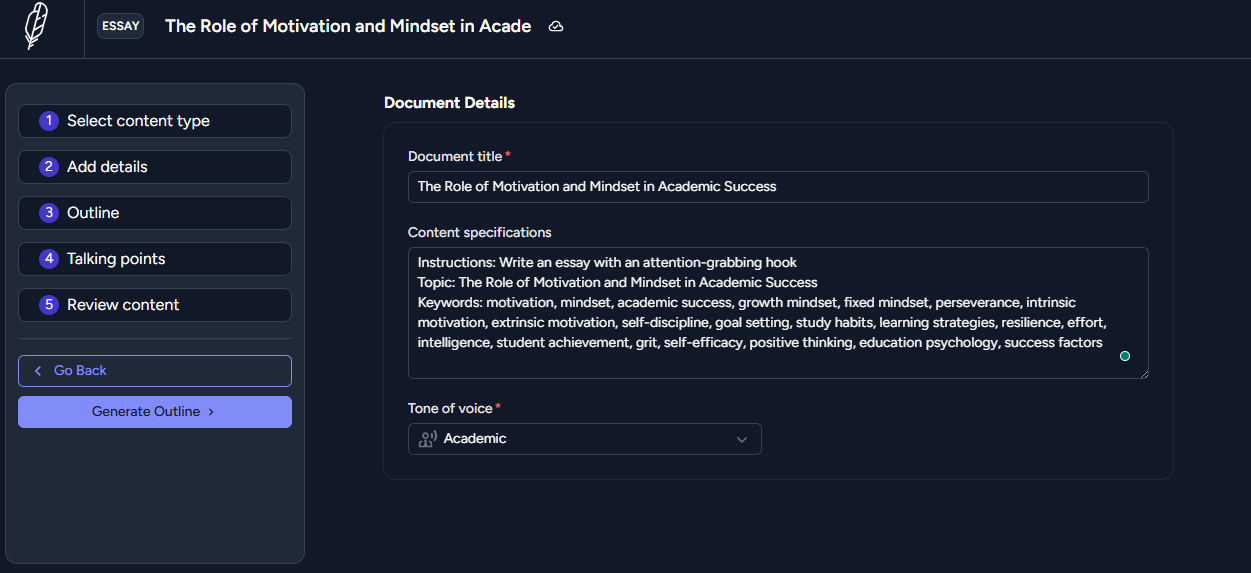For high school and university students, synthesis essays are a common yet challenging assignment. They can often be confusing and seem difficult to write. Only when you learn how to write a synthesis essay and the required gadgets can the task be straightforward. This article attempts to clarify what a synthesis essay is, how it varies from other essays, and the most effective ways to write one. We will also look at the ways in which AI tools can speed up and improve the process of writing an essay.
What is a Synthesis Essay
A synthesis essay is a type of academic work in which a writer integrates information from various documents to support a particular argument or idea. Rather than focusing on the summary of each document, your goal should be to relate them on a larger scale, formulating an assertion.
Bringing Together Different Perspectives
The goal of a synthesis essay is to integrate as many aspects of a topic as needed to accomplish a thorough understanding of it. Blending the ideas of different authors through various sources.
Critical Thinking and Connection
A synthesis essay requires an advanced level of analysis. You will do much more than give a collection of facts; you need to make sense of the information presented, describing relationships between different elements. It enables one to create an overall idea and to adopt the perspective of a general viewpoint.
The synthesis essay can help the student perceive the subject as multifaceted, motivating further research. It sharpens one's logic and analysis, making it easier to comprehend complex issues.
Constructing a synthesis essay is useful as it develops your research skills and your capacity to convey intricate ideas clearly.
Structure of the Synthesis Essays
A synthesis essay proves an argument using multiple sources. Like other essays, it has an introduction, body paragraphs, a conclusion, and a bibliography. Every section performs a different function in presenting your argument.
Introduction
Every essay begins with an introduction which is meant to inform the reader about a particular issue, and in this case, the problem that will be discussed in detail. It gives a general view of the ideas and controversies that relate to the topic. Your last sentence in this section should be a thesis statement; it should outline the goal of your essay and the main argument that will be supported through the essay.
Body Paragraphs
The body is typically split into three distinct paragraphs. The first two contain the proof and explanations supporting the claim you wish to make. In these paragraphs, you place arguments to the ideas drawn from your sources, explaining why the chosen source supports your claim. Each of the body paragraphs should add some aspect to your argument and give some assessment of the sources provided. In the third body paragraph, you present the other side of the argument or criticism you are trying to refute.
Conclusion
The conclusion explains the arguments made in the essay and restates the thesis. Its’ purpose is not to provide new insights but, rather, to summarize the elements and claims that support your central argument. Furthermore, a conclusion has the potential to be a call to action and suggest further study on the topic. This step generally depends on the topic itself and sometimes can be unnecessary.
Bibliography
The bibliography is the final section. It’s intended for listing the sources you have used in the essay. The format of the bibliography can differ. There are a few formats, such as APA or MLA, that depend on the required citation style. Each style has its own guidelines. That’s why it’s crucial to follow the correct one.
Example: APA: Smith, J. A. (2021). The psychology of learning. Oxford University Press.
MLA: Smith, John. The Psychology of Learning. Oxford University Press, 2021.
By following this structure, your synthesis essay will be clear and organized.
Tips to Write the Best Synthesis Essays
Writing a synthesis essay is not only about collecting information from different sources. It is equally challenging and requires constructing an argument that is convincing and comprehensive. Here are some essential tips for writing a synthesis essay that will be both effective and well-structured:
1. Clarify Your Purpose and Thesis
Every good synthesis essay starts with understanding the reason and aim of writing the essay. Try to ask the important question that guides your argument. In answering that question, you create an appropriate thesis statement, which is the most significant part or vital element of your essay. Formulate the statement or define the aspect that your essay intends to argue and figure out what guidance you intend to give the readers.
A good thesis must be very precise and must be arguable for it to be debatable. Your position taken in the thesis will dictate how you will argue in your essay and analyze your sources.
2. Select and Familiarize Yourself with Sources
Writing a synthesis essay starts with the selection of accurate and legitimate sources. Ensure to gather relevant material that can help you defend your thesis. Make sure to go over the sources you have gathered deep enough so that you can discuss each source. This understanding enables you to compare and contrast their contents with respect to your thesis and analyze them intelligently.
Applying quotation marks does not mean one has fulfilled one's responsibility towards the source. Sources should work based on your claims, not against them. Rather, when utilized appropriately, they build up the claims in the essay, making the essay better.
3. Organize Your Ideas with a Clear Plan
An effective synthesis essay needs good organization. Structure your essay in such a way that it does not come off as random. Instead of listing the arguments from the respective sources, cluster them into themes or points that can be related to your thesis. Your organizational plan determines how clear, concise, and logical the essay will be based on how each individual paragraph meets the well-set supporting thesis statement.
Also, adding additional sources to each point will strengthen your argument. By considering how different sources agree, disagree, or complement each other, you help deepen parts of your synthesis essay. This also demonstrates your visualization skills. Considering the validity and reliability of each relevant source will determine which ones are most useful in supporting your argument.
4. Evaluate, Interpret, and Show Relationships
A synthesis essay is much more than summarizing the sources; it requires proper analysis of every single one of them. Rather than treating sources as standalone pieces of information, consider how they interact with one another and how they work together to form cohesive arguments. For this specific part, you may ask yourself: What role does this source play in proving my argument? Does it refute another source? Does it provide other viewpoints that I can use in my discussion?
After you have analyzed the sources, it is time to depict relationships that exist among them. This is where your critical thinking skills are crucial. Show how various sources relate to one another and how they relate to your thesis. Comparing or contrasting the sources helped to clarify your argument. Besides, it improves the analysis you’re conducting.
Remember that it’s better to focus on a single purpose. Start by carefully selecting and evaluating sources. Then, organize your ideas in order of importance and engage with the sources critically.
How to Write a Synthesis Essay with AI Tools | A Step-by-step Guide with GetCopy
AI can be very helpful when writing a synthesis essay due to its capability to merge and organize various pieces of information. These tools can scan through large amounts of text quickly, understand the important concepts, and analyze how various opinions correlate with each other. The argument that is constructed has the broadest range of opinions but is well structured.
AI can also help clarify how the essay could be organized in terms of coherency and flow, making it easier for the writer to put together an essay.
Additionally, AI tools help expedite the research of pertinent articles and studies, saving writers considerable time. AI can also assist in rewriting and summarization, promoting the mixing of information without plagiarism. With all these characteristics incorporated into AI, the technology takes care of synthesis essays, while the writer only needs to focus on critical analysis and research.
With its easy-to-use interface and exceptional navigation features, GetCopy AI is another platform that can assist users in writing a synthesis essay. Below are the basic steps involved:
Craft a “Wizard Document” and select “Essay” as the content type. After typing in your necessary information (keywords, topic), choose the tone of your essay. Then, click on “Generate Outline” to provide the answer to your essay question.

Here is an example of the synthesis essay information. The chosen topic is “How Digital Minimalism Affects Mental Health and Productivity.” Therefore, the keywords will be “Digital minimalism, mental health, productivity, social media, screen time, technology habits, mindfulness,” and the audience will be “Young adults, professionals, digital users, mental health advocates, and anyone interested in improving their tech habits.”
Once the outline is ready, you can generate talking points and make any necessary adjustments. Finally, click "Generate Content" to fill in the details.
If you wish to alter anything, feel free to regenerate or edit the content that has been provided. Once you're done with the essay, click on “Save and Edit Document” and you are done.
Though AI tools can offer help during the writing process, they should not replace your critical thinking, only aid it. Crafting an essay for synthesis will always involve originality, proper structure, as well as a captivating design.
FAQs
What is a synthesis, and how is it different from other essays?
A synthesis essay is a form of writing that combines various sources to support one singular idea or topic. In contrast, other types of essays may focus on personal opinions or descriptions of a topic. A synthesis essay requires a critical level of analysis and consideration of opposing views.
What procedures are necessary for finding appropriate sources for a synthesis essay?
For the essay's sources, ensure they provide comprehensive coverage of different perspectives, are helpful for the thesis, and are credible to an extent. Refrain from using sources that present the same repeated opinions or ideas. As with a detailed synthesis essay, there is a need for sources with differing views, which can be used for juxtaposition and comparison towards an argument.
What part do AI tools have in writing synthesis essays?
Organizing main ideas, identifying repeating themes, and summarizing documents from multiple sources can be documented by advanced technology. These tools, when collecting materials, also enhance efficiency by suggesting changes in the structure and logical order of the argument. With this type of automation, the writer can shift their focus from producing a rough outline of the essay to more nuanced forms of intellectual engagement, such as critical thinking.
Instead of spending time proving and arranging an argument, writers can dedicate their time to thinking critically and analyzing the material.
How can I create a strong thesis for a synthesis essay?
In a synthesis essay, the primary focus should be narrowed down to a single point that can be argued for or against. Take a look at the documents and decide how you plan to prove your statement, then make sure your main point accurately reflects that. Constructing a well-formulated main point enables a writer to focus throughout the writing stage while also making sure that the essay contains all five components that revolve around the thesis presented in the introduction.
What is the best strategy for organizing a synthesis essay?
Like any other essay, a synthesis essay starts with an introduction that states the issue at hand and provides a thesis statement. The body paragraphs should build up the argument and include grouped sources that show relationships to each other. The argument should be summarized at the end alongside further recommendations for research or action. To make your argument stronger, avoid organizing your essay by each individual source and instead do so thematically or by viewpoint.
May I rely on AI to paraphrase or summarize the sources of my synthesis essay?
Of course, any AI writing tool can paraphrase and summarize information, which allows one to skip quoting the text directly and still capture all the necessary ideas. This guarantees the proper synthesis of information for the essay while maintaining proper attribution and credibility.

